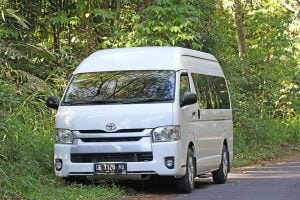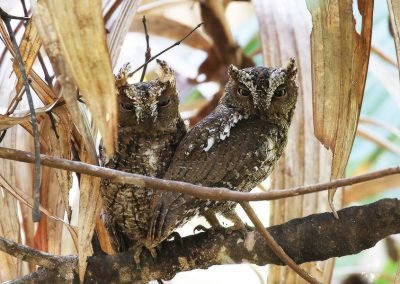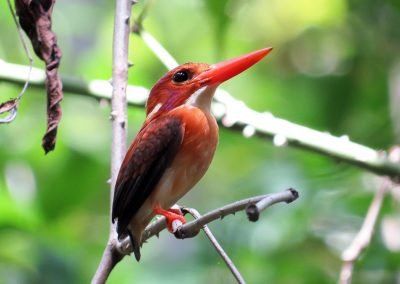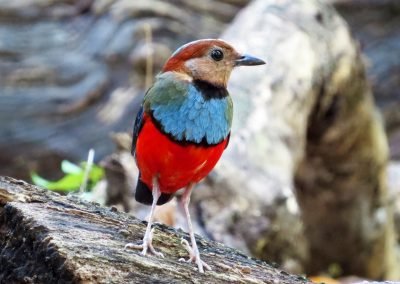Sulawesi Birding Trip
by Sultan Birding Tours IndonesiaBirding Sulawesi, Birdwatching Sulawesi, Sulawesi Birding Tour
Sulawesi Birdwatching, Tangkoko birdwatching, Birding Tangkoko,
Birding Lore Lindu, Malino birding and Ramang-ramang birdwatching
Introducing Sulawesi, Dazzling Birds on An Island Rich in Culture
Sulawesi has some really dazzling birds. Just a perusal of the names is enough to get the andrenalin going: Purple-bearded Bee-eater, Sulawesi Lilac cheeked Kingfisher, Fiery-browed Myna, and Great-Shortwing. An assortment of unusual mammals – the strange Babirusa of “pig deer”, The rare see Anoa ( a dwarf buffalo), three unique species of tarsier, and seven unique species of macaque – add to the excitement of being in the forest. World-class snorkeling and diving are available whenever you need to cool off. Birders will gravitate towards the northern peninsula and central Sulawesi, where the largest areas of rainforest are found, and in particular to the huge national parks of Lore Lindu, 100 km south of the provincial capital, Palu. Dumoga Bone, on the “northern neck”, and the much smaller reserve of Tangkoko – Dua Sudara, on the tip of the Minahasa peninsula. with 120 endemic species to go for, the birder will find Sulawesi a real Mecca. it is quite possible to see 80% of these endemics in a 3 – week trip with a little effort and planning. Sulawesi is the highest level of endemism in Indonesia, of 421 bird species known from the island, approximately 88 (27%) are found nowhere else. Fourteen genera are so unusual that they are considered unique to Sulawesi.
 We are a local birding tour operator who has been organized custom birding tours for individuals and private small groups of birdwatchers and bird photographers from around the world to Sulawesi of Indonesia. Our services are ranged from medium to high category in accommodation and meals depending on your needs. We provide Sulawesi birding packages including all services from your arrival until your departure from Sulawesi of Indonesia. We help you to set the ideal itinerary considering your main requirements as well as the birds you want to watch during your birding trip and bird-watching tours in Sulawesi. We also provide all land transportation and a knowledgeable birding guide who will take you to the specific birding site for you to watch or take a picture of your target birds. Let us know the interests of your birding journey to Sulawesi, and we will be glad to advise and assist you in planning the itinerary that suits better to fulfill your expectations. Sulawesi birding tour we can start from Makassar in South Sulawesi and end up in Manado in the north of Sulawesi, or Sulawesi birding trip we can start also from Manado and end up in Makassar South of Sulawesi and in Palu of Central Sulawesi.
We are a local birding tour operator who has been organized custom birding tours for individuals and private small groups of birdwatchers and bird photographers from around the world to Sulawesi of Indonesia. Our services are ranged from medium to high category in accommodation and meals depending on your needs. We provide Sulawesi birding packages including all services from your arrival until your departure from Sulawesi of Indonesia. We help you to set the ideal itinerary considering your main requirements as well as the birds you want to watch during your birding trip and bird-watching tours in Sulawesi. We also provide all land transportation and a knowledgeable birding guide who will take you to the specific birding site for you to watch or take a picture of your target birds. Let us know the interests of your birding journey to Sulawesi, and we will be glad to advise and assist you in planning the itinerary that suits better to fulfill your expectations. Sulawesi birding tour we can start from Makassar in South Sulawesi and end up in Manado in the north of Sulawesi, or Sulawesi birding trip we can start also from Manado and end up in Makassar South of Sulawesi and in Palu of Central Sulawesi.
 Why we organize custom birding tours in Sulawesi for individuals and private groups? Because clients can follow their own itinerary to suit their own personal taste, whether it be birds, wildlife, other mammals, other natural wonders. On custom birding tours those taking part can specify the pace and the sites and species they wish to concentrate on. The custom birding tours in Sulawesi that we organize for individuals and small groups also suit people who like to travel with people they already know.
Why we organize custom birding tours in Sulawesi for individuals and private groups? Because clients can follow their own itinerary to suit their own personal taste, whether it be birds, wildlife, other mammals, other natural wonders. On custom birding tours those taking part can specify the pace and the sites and species they wish to concentrate on. The custom birding tours in Sulawesi that we organize for individuals and small groups also suit people who like to travel with people they already know.
Upcoming Departure 2023
Sulawesi Birding Trip 15 days / 14 Nights
Price US$ Per Person ( Min. 2 Person)
Price included: English Speaking Bird Guide, Mineral water, Snacks, Meals (breakfast, lunch, and dinner), Accommodation during the trip, Entrances to Parks and Reserves, Local guides, local park ranger, birding site fee, landowner fee, Private car.
Price not included: Domestic flight tickets, Insurance, Alcoholic Beverages, Laundry, Tips, All personal expenses that are not mentioned on the items above, and Any kind of expenditures incurred due to flight cancellation/delays or due to other causes beyond our control. Kindly please book in advance to ensure availability.
Sulawesi birding trip for 2023, please choose one of the summaries of new birding plans below:
Sulawesi birding trip 15 days / 14 nights
Birding code: 01/15 days/SBT
Summary:
day 01: Makassar arrival – Malino
day 02: Malino birding full day
day 03: Malino – Ramang ramang
day 04: Ramang-ramang birding
day 05: Raman ramang – Airport, fly to Palu – Lore Lindu
day 06: Lore Lindu National Park
day 07: Lore Lindu National Park
day 08: Lore Lindu – Palu
day 09: Palu – Makassar – Manado – Tomohon
day 10: Tomohon Gunung Mahawu birding
day 11: Tomohon – Tangkoko
day 12: Tangkoko Nature Reserve
day 13: Tangkoko Nature Reserve
day 14: Tangkoko Nature Reserve – Manado (tongkaina)
day 15: Morning birding in Gunung Tumpa – Transfer to the airport
Sulawesi birding trip 15 days / 14 nights
Birding code: 02/15 days/SBT
Summary:
day 01: Manado arrival – Tangkoko Nature Reserve
day 02: Tangkoko
day 03: Tangkoko
day 04: Tangkoko – Tomohon
day 05: Tomohon
day 06: Manado – Makassar – Palu – Lore Lindu
day 07: Lore Lindu National Park
day 08: Lore Lindu – Palu
day 09: Palu – Makassar – ramang2
day 10: ramang – ramang
day 11: ramang – ramang
day 12: Ramang – ramang to Malino
day 13: Malino
day 14: Malino – Makassar
day 15: Transfer to the airport
SULAWESI BIRDING PACKAGE 15 DAYS 14 NIGHTS
- Sulawesi hot birding spot destinations
- Availability: Set Departure
- Tour Type: Multi-Day Tour
- Duration:15 Days / 14 Nights
- Best Time: Throughout The Year
What is included?
- English Speaking Bird Guide fee
- Mangrove boat Trip near Tangkoko Park
- Meals, daily breakfast, lunch, and Dinner
- All accommodations during the trip
- Entrances to Parks and Reserves
- Local guide fee / Local ranger fee
- Car Transport during the trip
What is not included?
- Insurance
- Alcoholic Beverages
- Airfare or domestic flights
- Laundry
- Tips
- All personal expenses that are not mentioned on the items above.
- Any kind of expenditures incurred due to flight cancellation/delays or due to other causes beyond our control.
Payment Term and Condition
We require a minimum of 50% deposit payment to confirm your booking, we cannot guarantee your booking until this has been received. Bookings will be held for 7 days to allow the client time to send a deposit payment. We reserve the right to release the booking if the deposit is not received within 7 days of the booking being made. Changes of dates to bookings after the deposit has been made can be done but will be subject to availability.
Cancelation: Deposit payment No Refund, No show – full payment charge.
Full Payment, The full payment will be required at least 30 days prior to your date of arrival. The invoice amount has to be paid in full, net of all transfer costs and bank charges.
TYPE OF LAND TRANSPORTATION & ROAD
We will use a minibus or cars. The road is some part in good condition and some parts in bad condition. While for the mangrove boat trip, we will use a small boat.
BIRD GUIDE
This trip will be provided with an English speaking bird guide during the whole trip and a local guide (who owns/guard the land) for each place in Sulawesi
LIABILITY
Sultan Birding Tours acts only as agents for the passenger in regard to travel, whether by railroad, motorcar, motor coach, boat, or airplane, and assumes no liability for injury, damage, loss, accident, delay, or irregularity which may be occasioned either by reason of defect in any vehicle or for any reason whatsoever or through the acts or default of any company or person engaged in conveying the passenger or in carrying out the arrangements of the tour. Sultan Birding Tours can accept no responsibility for losses or additional expenses due to delays or changes in air or other services, sickness, weather, strike, war, quarantine, or other causes. All such losses or expenses will have to be borne by the passenger, as tour rates provide for arrangements only for the time stated. Baggage is at the owner’s risk entirely. The airlines concerned and their agents and affiliates are not to be held responsible for any act, omission, or event during the time passengers are not on board their aircraft.
Introducing Sulawesi, Dazzling Birds on An Island Rich in Culture
Sulawesi has some really dazzling birds. Just a perusal of the names is enough to get the andrenalin going: Purple-bearded Bee-eater, Sulawesi Lilac cheeked Kingfisher, Fiery-browed Myna, and Great-Shortwing. An assortment of unusual mammals – the strange Babirusa of “pig deer”, The rare see Anoa ( a dwarf buffalo), three unique species of tarsier, and seven unique species of macaque – add to the excitement of being in the forest. World-class snorkeling and diving are available whenever you need to cool off. Birders will gravitate towards the northern peninsula and central Sulawesi, where the largest areas of rainforest are found, and in particular to the huge national parks of Lore Lindu, 100 km south of the provincial capital, Palu. Dumoga Bone, on the “northern neck”, and the much smaller reserve of Tangkoko – Dua Sudara, on the tip of the Minahasa peninsula. with 120 endemic species to go for, the birder will find Sulawesi a real Mecca. it is quite possible to see 80% of these endemics in a 3 – week trip with a little effort and planning. Sulawesi is the highest level of endemism in Indonesia, of 421 bird species known from the island, approximately 88 (27%) are found nowhere else. Fourteen genera are so unusual that they are considered unique to Sulawesi.
For those wishing to get well off the beaten track, however, Sulawesi has a fascinating collection of satellite islands to explore. Muna and Buton, off the southeast corner, are the largest, but the most interesting for birders are the Banggai Islands – home to a unique megapode and crow – off the Western peninsula, and Sangihe and Talaud, which have the dubious distinction of supporting the highest concentration of threatened birds species in Indonesia.
This 189,000 sq km island also boasts impressive landscapes and a fascinating range of cultures. Sulawesi is in essence a group of volcanoes and, if global warming were to raise the sea level just a few meters, it would become a cluster of islands separated by narrow straits, as the Philippines archipelago is today. Indeed, this was how Sulawesi appeared 4,000 years ago. Ritual in Sulawesi, as elsewhere in the archipelago, is not a rich part of the social calender but also an arena to display and assure health and status. Best known are the death rites of the Toraja, a distant ethnic group inhabiting the gloriously scenic Tana Toraja highlands in South Sulawesi. The Toraja are also famous for their beautifully carved “origin” houses, and effigy-guarded cliffside graves.

“Client Testimonials”
Dumoga Bone National Park
Day 328: The Maleo
In search of Sulawesi’s most-wanted bird.
November 24, 2015: Kota Mobagu, Sulawesi — Monal and I traveled from Palu to Manado via two short flights and a four-hour drive today, putting us at our destination in the late afternoon. For the rest of this year, I won’t have more than four straight days without hopping a flight. It can be tough to spend so much time in transit—you don’t see many birds from airplanes—but I must keep moving now to keep the pace.
This part of Asia has a big bird list, but many of those birds are spread out on various small islands, which makes it more difficult to be efficient. If I stay in one spot for two days in a row, there aren’t many new birds to find on the second day (at Lore Lindu, for instance, I saw 36 new birds on the first day and just seven on the second day). These diminishing returns must constantly be weighed against the time lost to traveling onward. It’s a delicate balance!
Monal wanted to reach a special spot before dusk today, so we pressed through Manado’s traffic with no stops. At 4 p.m. we pulled up at a couple of huts by a river in the forest. This, Monal said, was the nesting site of a very strange bird called the Maleo.
The Maleo is endemic to Sulawesi. It looks kind of like a chicken, though it’s not closely related to chickens; it’s in a family called “megapodes.” The Maleo nests in loose colonies where, like turtles, these birds bury their eggs in the ground and cover them with dirt. An adult Maleo isn’t much bigger than a chicken, but each egg is five times larger than a typical chicken egg. When the Maleo’s eggs hatch underground, the chicks must dig their way out (sometimes more than a meter to the surface!) and fend for themselves.
Maleos are endangered and red-listed. A few years ago, a program was started to hatch eggs in incubators before releasing the chicks back into the wild, which protects them from predators. You can still see Maleos at a couple of sites where blinds have been constructed for discreet viewing.
The place we visited this afternoon had a wooden tower next to the nesting ground, and a ranger accompanied us while we waited for the Maleos to make an appearance. Below us was a patch of bare dirt near the river bank with half a dozen recently dug-out spots where the birds bury their eggs. One Maleo can lay 12 eggs in a year, and there are about eight pairs using this site. We waited for an hour before one called loudly from across the river, and we heard a whirr of wings as it landed somewhere in a tree on the slope nearby.
It seemed like the bird would strut into the open at any minute, but we waited another hour without getting a visual. At intervals, we could hear the Maleo moving around in the foliage, but it was too dense to see where it perched. As the light faded into dusk, so did my hopes of seeing Sulawesi’s most-wanted bird, and with darkness, upon us, we reluctantly climbed down from the viewing tower.
“We have a difficult choice now,” said Monal when we reached the ground. “We can come back here in the morning to try again, or we can go somewhere else for several other birds. The two places are in opposite directions, so we can’t do both.”
As I digested this decision, the ranger was quietly looking around. Suddenly, before I could answer Monal’s question, he grabbed my arm and pointed upward. There, in the tree right above us, was the Maleo on its roost—we could just barely see it through a gap in the foliage! In the last five minutes before it was too dark to see, I snapped a couple of grainy photos. Oh, what a wonderful feeling it is to see a bird you thought you’d missed, especially when that bird happens to be a Maleo!
Day 329: Rafting for Birds
Noah catches up on sleep and finds a Speckled Boobook.
November 25, 2015: Tangkoko, Sulawesi — For the first time in a long time, I had nearly eight full hours of sleep last night, and woke up at five feeling refreshed. I swear, there just aren’t enough hours in the day. Whoever repeats this trip a few million years from now will have a big advantage, because the Earth’s rotation will have slowed enough to add an extra hour.
Seriously, did you know that when the dinosaurs lived, a day was only 23 hours long? That would really have handicapped a big year! Of course, the dinosaurs were birds, and today’s birds are dinosaurs (slightly more evolved), but counting dinosaurs might have been more hazardous. A logical conclusion lies here somewhere, which is that I need more sleep.
Monal and I kicked around a place called Toraut this morning accompanied by a local ranger named Hendrik. Touraut is a nice patch of lowland forest on the north tip of Sulawesi (the part that looks like a four-legged starfish’s raised fist) with some equally nice birds. To get into the forest, Hendrik poled us across a shallow river on a bamboo raft—a new method of transportation for my year list. I saw a Speckled Boobook, a pair of Maroon-chinned Fruit-Doves, and a Lilac-cheeked Kingfisher which didn’t mind being stared at. By the time Hendrik poled us back out of the forest before lunch, I was sweaty enough to consider just wading across the river. Yesterday I slipped into a rice paddy and wet my shoes up to the knee, and didn’t mind a bit.
We spent the afternoon retracing yesterday’s route through Manado’s traffic jams and out the other side, arriving at Tangkoko after dark. Sulawesi’s roads are twisty and narrow, sometimes barely wide enough to admit two vehicles traveling in opposite directions, so getting from one place to another is a deliberate process. I amused myself by watching my iPhone’s GPS readout, tracking our speed; we rarely exceeded 40 miles per hour on the open highway and averaged a walking pace in towns. This allowed plenty of opportunities to soak in the smells of fried fish, the sights of fresh produce stands, the sounds of prayers being sung at mosques, and the feel of the ocean breeze as we slid along the coast. More birds await in the morning.
Noah Keefer Strycker (born February 9, 1986) is an American birdwatcher. In 2015, he set a record for a worldwide Big Year of birding, seeing 6,042 of the world’s estimated 10,400 bird species in a continuous journey spanning all seven continents from January 1 to December 31, 2015. ( Monal at Sultan birding Tours proud have been organized Noah’s birding trip in Sulawesi of Indonesia)



















